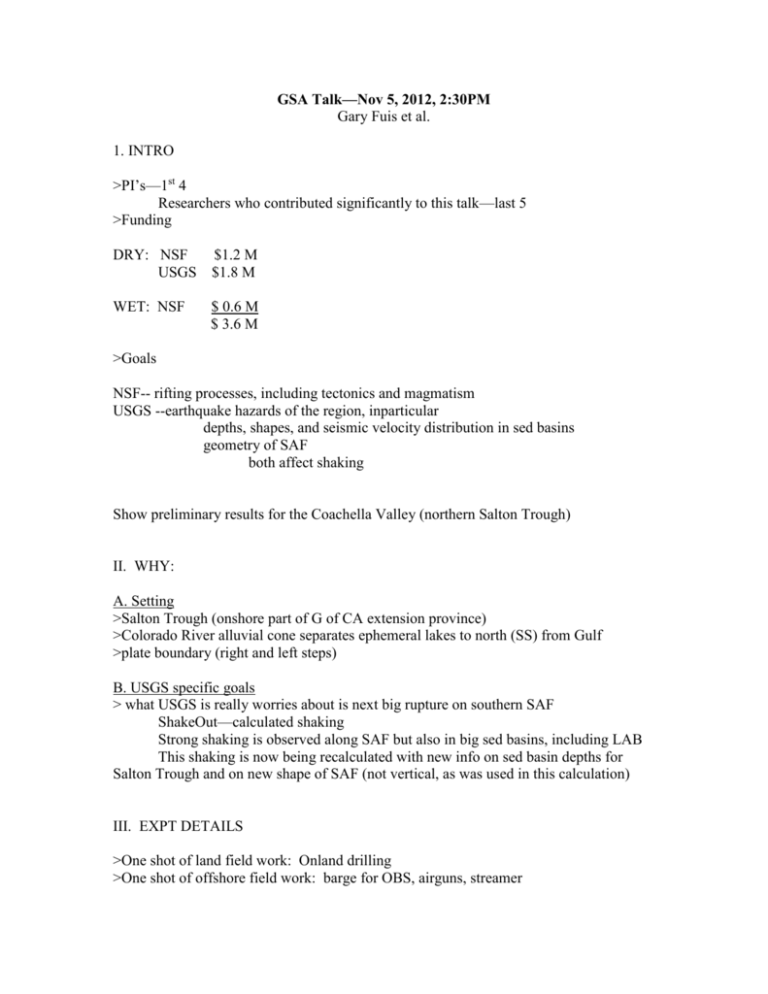Fuis_talk2012
advertisement

GSA Talk—Nov 5, 2012, 2:30PM Gary Fuis et al. 1. INTRO >PI’s—1st 4 Researchers who contributed significantly to this talk—last 5 >Funding DRY: NSF USGS $1.2 M $1.8 M WET: NSF $ 0.6 M $ 3.6 M >Goals NSF-- rifting processes, including tectonics and magmatism USGS --earthquake hazards of the region, inparticular depths, shapes, and seismic velocity distribution in sed basins geometry of SAF both affect shaking Show preliminary results for the Coachella Valley (northern Salton Trough) II. WHY: A. Setting >Salton Trough (onshore part of G of CA extension province) >Colorado River alluvial cone separates ephemeral lakes to north (SS) from Gulf >plate boundary (right and left steps) B. USGS specific goals > what USGS is really worries about is next big rupture on southern SAF ShakeOut—calculated shaking Strong shaking is observed along SAF but also in big sed basins, including LAB This shaking is now being recalculated with new info on sed basin depths for Salton Trough and on new shape of SAF (not vertical, as was used in this calculation) III. EXPT DETAILS >One shot of land field work: Onland drilling >One shot of offshore field work: barge for OBS, airguns, streamer > expt layout >lines 1-7 focus on Lines 6,5,4,7 (northern Salton Trough) IV. NEW RESULTS: >Line 6 velocity model --3 branches of SAF, GH, BF active, MC inactive --PAC different velocity structure than NAM: higher velocity (up to over 6.5 km/s) higher velocity gradient --PAC (Peninsular Ranges batholithic rx) extends beneath the two active traces of SAF >Line 6 vel mod + seismicity --Seismicity—quakes from 2081-2010 within +/- 2.5 km zone on either side of CS These are mostly quakes associated with the 1986 M 6.1 North Palm Springs quake. FM for largest quakes indicate SS on moderately NE dipping plane Can distinguish perhaps two faults in the seismicity >Line 6 vel mod + seismicity + faults (+ rx) --Garnet Hill + Banning --MC inactive, may dip steeply SW based on nearby high-res imaging >Line 5 location > Line 5 velocity model --2 branches of SAF, MC active, BF inactive --PAC (Peninsular Ranges bath rx) same hi vel (up to > 7 km/s) / hi vel grad --NAM similar but more poorly constrained on Line 5 --Here, no clear distinction between plates in fact, based on v mod alone, looks like a separation SW of SAF branches SW dip? --Maybe, can’t tell from refraction alone. Seismicity may give a hint >Line 5 vel mod + seismicity --NE of SAF and mod NE dipping base --mostly quakes from the 1992 M 6.__ Joshua Tree sequence (ss mechanisms) >Line 5 vel mod + seismicity + faults + rx --drawn in fault dip determined from magnetics from 9 km SE --no proof, but seismicity and magnetic data consistent with NE dip refraction data not >Line 4 location >Prior seismicity studies by Lin Shearer and Hauksson (2007) --planar NE dipping structures near Lines 4 & 7 --not clearly related to secondary faults—although interpreted this way by other researchers --many focal mechanisms indicate strike slip on a dipping surface --this section of SAF creeps: In many other locations, creeping SAF has microseismicity that appears to define the fault plane (streaky) >Line 4 velocity model --again, PAC (Pen R) high velocity (up to > 7 km/s) and hi vel grad; NAM lo vel, lo vel grad > Line 4 vel mod + SAF --have drawn SAF to separate these two velocity units --Pen Ranges batholithic rx/ Orocopia Schist > Line 4 vel mod + SAF + seismicity --seismicity and refraction model consistent with NE dip >Line 7 location Hopes for resolving SAF dip were highest with Line 7: --straight --minor elevation changes --fewer geologic units outcrop at surface—exclusively sed beds from Salton Trough infilling >Line 7 velocity model --features: SS Coast SAF Minor fault --In seds (<5 km/s) clear evidence of east-dipping LVZ --Not so clear in basement, but basement not well sampled > Line 7 vel mod + SAF + qks + potential field data > Line 7 potential field model: uplifted folded seds seen NE of dipping SAF modeled as magnetic bodies --fair match >Line 7 pot field mod tweak: add sliver of magnetic rx on SW side of fault --good match >Line 7 pot field mod: vertical SAF --fair match to pot field data --poor match to quakes We are working on wide-angle reflection data, but no magic bullet there Summary: NE dipping SAF matches all data better than vertical SAF, but, of course, no proof >Line 7 location again: vertical-incidence data collected offshore >Line 7 vertical-incidence reflection data --show eastward dip and thickening of beds Origin of this reflectivity pattern appears to be NE tilting of Peninsular Ranges block: as documented by 1) geological investigation—Becky Dorsey and colleagues 2) deformation modeling of NE dipping SAF—Michele Cooke and student Laura Fattaruso >Geologic cross section, showing a NE tilted WSDF with Pliocene marine beds on top of the detachment fault uplifted by 600-1000 m >Plan view of tilting block from boundary-element modeling --differential uplift of Santa Rosa Mts wrt Coachella Valley along NE dipping SAF. -tilting caused as Pen Ranges block runs into the dipping fault on north side V. SUMMARY 1) Lines 6, 4, 7 have evidence in velocity structure for NE dip. Line 5 velocity structure does not support a NE dip; perhaps it weakly supports a SW dip. 2) Lines 6, 4, 7 have evidence in seismicity for NE dip. Line 5 has seismicity that is permissive/ suggestive of a NE dip. 3) Line 7 has weak evidence in potential-field data for a NE dip. 4) Geologic studies indicate NE tilting of the Peninsular Ranges block. 5) Deformation modeling indicate that NE tilting occurs with a NE-dipping SAF. END






